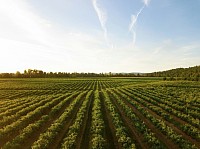Blog
Cultivating Success: The Essential Components of Agricultural Production
In the intricate tapestry of agriculture, the harmonious interplay of various elements is vital to nurturing bountiful harvests and sustaining agricultural ecosystems. From the humble seed to sophisticated agricultural machinery, each component plays a crucial role in shaping the landscape of agricultural production. Let's delve into the essential pillars of agricultural success: seed, fertilizer, agricultural machinery, soil fertility management, and agrochemicals.
Seed -
The Genesis of Growth: Seeds, the tiny vessels of life, hold the promise of abundant harvests. Through generations of selective breeding and genetic enhancement, modern agriculture has witnessed the evolution of high-yielding and resilient crop varieties. These seeds, meticulously developed and tested, form the foundation of agricultural productivity. Whether it's hybrid seeds engineered for superior disease resistance or genetically modified varieties tailored to thrive in adverse conditions, the quest for optimized seed performance drives innovation in agriculture.
visit: https://sarbagya.com/
Fertilizer -
Nourishing the Soil: Fertilizers, comprising a blend of essential nutrients, serve as the lifeblood of the soil, replenishing its nutritional reserves and fueling plant growth. From nitrogen-rich compounds to phosphorus and potassium formulations, fertilizers provide the vital elements necessary for robust crop development. However, the judicious application of fertilizers is paramount to prevent environmental degradation and optimize resource utilization. Through soil testing and precision application techniques, farmers can tailor fertilizer regimes to meet the specific needs of their crops while minimizing nutrient runoff and ecological impact.
Agricultural Machinery -
Powering Efficiency: In the modern agricultural landscape, the roar of engines and the hum of machinery herald the dawn of mechanized farming. From tractors and harvesters to precision planting equipment, agricultural machinery revolutionizes the way crops are cultivated, harvested, and processed. With the advent of automation and digital technologies, today's farm machinery boasts advanced features such as GPS guidance systems, real-time monitoring, and data analytics capabilities, enabling farmers to enhance operational efficiency, maximize yields, and minimize labor inputs.
Soil Fertility Management -
Nurturing the Earth: The health of the soil forms the bedrock of agricultural sustainability. Soil fertility management encompasses a holistic approach to soil health, encompassing practices such as crop rotation, cover cropping, and organic amendments. By fostering soil biodiversity, improving water retention, and mitigating erosion, sustainable soil management strategies enhance the resilience of agricultural ecosystems, safeguarding long-term productivity and environmental integrity.
Agrochemicals -
Balancing Act: While agrochemicals play a pivotal role in pest and disease management, their widespread use raises concerns about ecological impact and human health risks. Integrated pest management (IPM) approaches advocate for the judicious application of agrochemicals in conjunction with cultural and biological control measures to minimize environmental harm while effectively controlling pests and diseases. Through ongoing research and regulatory oversight, the agricultural industry strives to develop safer, more sustainable agrochemical solutions that strike a balance between productivity and environmental stewardship.
In conclusion, the synergy of seed, fertilizer, agricultural machinery, soil fertility management, and agrochemicals forms the cornerstone of modern agricultural production. By embracing innovation, stewardship, and a holistic approach to sustainability, farmers can harness the full potential of these essential components to cultivate success in the fields and ensure a thriving future for generations to come.

